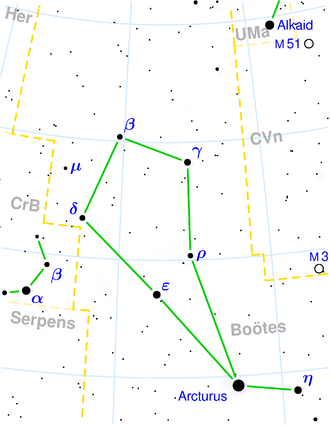IC 1008
| Galaxie IC 1008 / IC 4414 | |
|---|---|
 | |
| SDSS-Aufnahme | |
| AladinLite | |
| Sternbild | Bärenhüter |
| Position Äquinoktium: J2000.0, Epoche: J2000.0 | |
| Rektaszension | 14h 23m 42,6s[1] |
| Deklination | +28° 20′ 52″[1] |
| Erscheinungsbild | |
| Morphologischer Typ | P+C[2] |
| Helligkeit (visuell) | 1: 14,5 mag 2: 15,3 mag[2] |
| Helligkeit (B-Band) | 1: 15,3 mag 2: 16,3 mag[2] |
| Winkelausdehnung | 1: 0,40' × 0,3' 2: 0,20' × 0,2'[2] |
| Positionswinkel | 1: 0°[2] |
| Flächenhelligkeit | 1: 12,0 mag/arcmin² 2: 11,7 mag/arcmin²[2] |
| Physikalische Daten | |
| Rotverschiebung | 0.030034 ± 0.000160[1] |
| Radialgeschwindigkeit | (9004 ± 48) km/s[1] |
| Hubbledistanz vrad / H0 | (405 ± 28) · 106 Lj (124,2 ± 8,7) Mpc [1] |
| Geschichte | |
| Entdeckung | Truman Safford |
| Entdeckungsdatum | 4. Mai 1866 |
| Katalogbezeichnungen | |
| IC 1008/4414 • PGC 51414 • CGCG 163-035 • MCG +05-34-027 • | |
IC 1008 = IC 4414 ist ein interagierendes Galaxienpaar vom Hubble-Typ P+C im Sternbild Bärenhüter am Nordsternhimmel. Es ist schätzungsweise 405 Millionen Lichtjahre von der Milchstraße entfernt.
Das Objekt wurde am 4. Mai 1866 vom US-amerikanischen Astronomen Truman Henry Safford entdeckt.[3]
Weblinks
Einzelnachweise
Auf dieser Seite verwendete Medien
Autor/Urheber: Sloan Digital Sky Survey, Lizenz: CC BY 4.0
The sky image is obtained by Sloan Digital Sky Survey, DR14 with SciServer.
Angle of view: 4' × 4' (0.3" per pixel), north is up.
Details on the image processing pipeline: https://www.sdss.org/dr14/imaging/jpg-images-on-skyserver/



